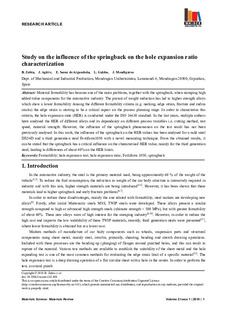| dc.rights.license | Attribution-NonCommercial 4.0 International | * |
| dc.contributor.author | Zubia, Biotza | |
| dc.contributor.author | Mendiguren, Joseba | |
| dc.contributor.author | GALDOS, Lander | |
| dc.contributor.author | Sáenz de Argandoña, Eneko | |
| dc.contributor.author | Agirre, Julen | |
| dc.date.accessioned | 2018-07-26T14:58:04Z | |
| dc.date.available | 2018-07-26T14:58:04Z | |
| dc.date.issued | 2018 | |
| dc.identifier.issn | 2529-7791 | eu_ES |
| dc.identifier.other | https://katalogoa.mondragon.edu/janium-bin/janium_login_opac.pl?find&ficha_no=147900 | eu_ES |
| dc.identifier.uri | https://hdl.handle.net/20.500.11984/1096 | |
| dc.description.abstract | Material formability has become one of the main problems, together with the springback, when stamping high
added-value components for the automotive industry. The pursuit of weight reduction has led to higher strength alloys
which show a lower formability. Among the different formability criteria (e.g. necking, edge strain, fracture and radius
cracks) the edge strain is starting to be a critical aspect on the process planning stage. In order to characterise this
criteria, the hole expansion ratio (HER) is conducted under the ISO 16630 standard. In the last years, multiple authors
have analysed the HER of different alloys and its dependency on different process variables i.e. cutting method, test
speed, material strength. However, the influence of the springback phenomenon on the test result has not been
previously analysed. In this work, the influence of the springback on the HER values has been analysed for a mild steel
DX54D and a third generation steel Fortiform1050 with a novel measuring technique. From the obtained results, it
can be stated that the springback has a critical influence on the characterised HER value, mainly for the third generation
steel, leading to differences of about 40% on the HER limits. | |
| dc.language.iso | eng | eu_ES |
| dc.publisher | Whioce Publishing | eu_ES |
| dc.rights | © 2018 B. Zubia et al. | eu_ES |
| dc.rights.uri | https://creativecommons.org/licenses/by-nc/4.0/ | * |
| dc.subject | Formability | eu_ES |
| dc.subject | hole expansion test | eu_ES |
| dc.subject | hole expansion ratio | eu_ES |
| dc.subject | Fortiform 1050 | eu_ES |
| dc.subject | springback | eu_ES |
| dc.title | Study on the influence of the springback on the hole expansion ratio characterization | eu_ES |
| dcterms.accessRights | http://purl.org/coar/access_right/c_abf2 | eu_ES |
| dcterms.source | Materials Science: Materials Review | eu_ES |
| local.contributor.group | Procesos avanzados de conformación de materiales | eu_ES |
| local.description.peerreviewed | true | eu_ES |
| local.identifier.doi | https://doi.org/10.18063/msmr.v2i1.408 | eu_ES |
| local.source.details | Vol. 1. Nº. 1 | eu_ES |
| oaire.format.mimetype | application/pdf | |
| oaire.file | $DSPACE\assetstore | |
| oaire.resourceType | http://purl.org/coar/resource_type/c_6501 | eu_ES |
| oaire.version | http://purl.org/coar/version/c_970fb48d4fbd8a85 | eu_ES |








